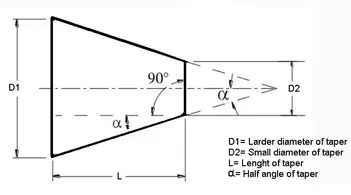Taper Turning:
- A ”taper” is the uniform increase or decrease in the diameter of the workpiece and measured along with its length.
- Taper turning means to produce a conical shape by a gradual reduction in diameter from a cylindrical workpiece.

The amount of taper in the workpiece is usually specified on the basis of the difference in diameter of the taper to its length. It is known as a cone and it is indicated by the letter K.
It has the formula K = D-d / 1 to produce the taper on the workpiece.
- D = Larger diameter of taper.
- d = Small diameter of taper.
In the case of a lathe, the taper on a given workpiece is obtained by tuning the job and feeding the tool at an angle to produce a gradual increase or decrease in the diameter of the workpiece.
Chamfering operation:

It is the operation of getting a bevelled surface at the edge of a cylindrical workpiece. This operation is done in case of bolt ends and shaft ends. Chamfering helps to avoid damage to the sharp edges and protect the operation getting hurt during other operations. Chamfering on bolt helps to screw the nut easily.
Knurling operation:
It is an operation of obtaining a diamond shape on the workpiece for the gripping purpose. This is done to provide a better gripping surface when operated by hands. It is done using a knurling tool. The tool consists of a set of hardened steel roller, and it is held rigidly on the toolpost.

Knurling is done at the lowest speed available on a lathe. It is done on the handles and also in case of ends of gauges. The feed varies from 1 to 2 mm per revolution. Two or three cuts may be necessary to give the full impression.
Thread cutting:
It is the important operation in the lathe to obtain the continuous ”helical grooves” or ” threads’‘.
When the threads or helical grooves are formed on the out surface of the workpiece is called external thread cutting. When the threads or helical grooves are formed on the inner surface of the workpiece is called internal thread cutting. The workpiece is rotating between the two centres i.e., live centre and dead centre os the lathe.

Here the tool is moved longitudinally to obtain the required type of the thread. When the tool is moved from right to the left we get the left-hand thread. Similarly, when the tool is moved from left to the right
